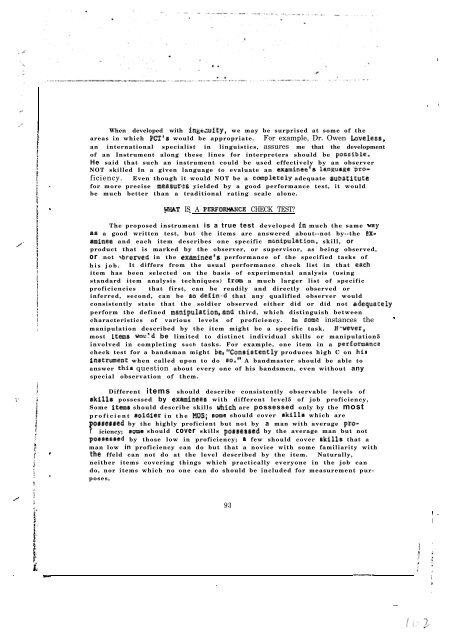Technical Report - International Military Testing Association
Technical Report - International Military Testing Association
Technical Report - International Military Testing Association
Create successful ePaper yourself
Turn your PDF publications into a flip-book with our unique Google optimized e-Paper software.
i’<br />
I<br />
.<br />
.<br />
When developed with ing;t,2uity, we may be surprised at some of the<br />
areas in which PCT’s would be appropriate. For example, Dr. Owen Waveless,<br />
an international specialist in linguistics, assures me that the development<br />
of an Instrument along these lines for interpreters should be ponsible.<br />
He said that such an instrument could be used effectively by an observer<br />
NOT skilled In a given language to evaluate an axaminee’a ~aneuaw’imJficiency.<br />
Even though it would NOT be a canpletely adequate aubstltute<br />
for more precise measurlas yielded by a good performance test, it would<br />
be much better than a traditional rating scale alone.<br />
. WHAT IS A PERFORIWXE CHECK TEST?<br />
- -<br />
.<br />
Y<br />
The proposed instrument is a true test developed In much the same wa,y<br />
aa a good written test, but the items are answered about--not by--the examinee<br />
and each item describes one specific mnnipulation, skill, or<br />
product that is marked by the observer, or supervisor, as being observed,<br />
or not -brerved in the examinee’s performance of the specified tasks of<br />
his job. It differs from the usual performance check list in that each<br />
item has been selected on the basis of experimental analysis (using<br />
standard item analysis techniques) frcxn a much larger list of specific<br />
proficiencies that first, can be readily and directly observed or<br />
inferred, second, can be so defined that any qualified observer would<br />
consistently state that the soldier observed either did or did not odequcll;ely<br />
perform the defined manipulation,and third, which distinguish between<br />
characteristics of various levels of proficiency. In some instances the ’<br />
manipulation described by the item might be a specific task. H,-wever,<br />
most items wou!d be limited to distinct individual skills or manipulation5<br />
involved in completing such tasks. For example, one item in a performanoe<br />
check test for a bandsman might be,“Consistently produces high C on his<br />
inetrument when called upon to do so.” A bandmaster should be able to<br />
answer this question about every one of his bandsmen, even without any<br />
special observation of them.<br />
Different items should describe consistently observable levels of<br />
skills possessed by examineee with different level5 of job proficiency,<br />
Some items should describe skills whfch are possessed only by the most<br />
proficient soldier in the MOS; Borne should cover skill8 which are<br />
porseoeed by the highly proficient but not by a man with average prof<br />
iciency; come should cover skills possessed by the average man but not<br />
poclstseed by those low in proficiency; a few should cover skill8 that a<br />
man low in proficiency can do but that a novice with some familiarity with<br />
the ffeld can not do at the level described by the item. Naturally,<br />
neither items covering things which practically everyone in the job can<br />
do, nor items which no one can do should be included for measurement purposes,<br />
.<br />
93<br />
---<br />
-<br />
,<br />
, . !<br />
1 .<br />
I<br />
i<br />
6<br />
,









